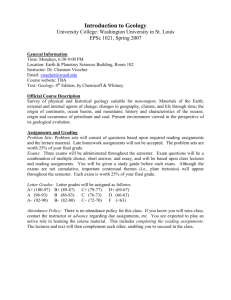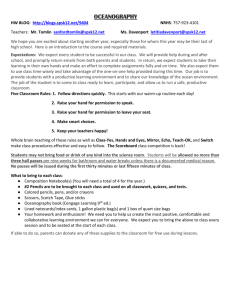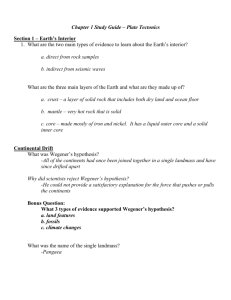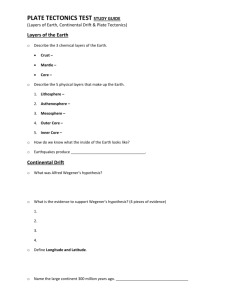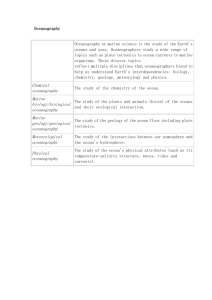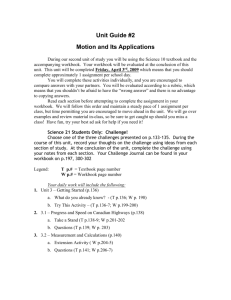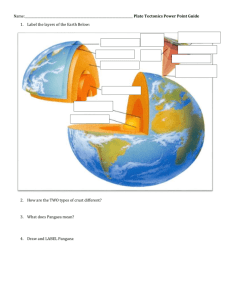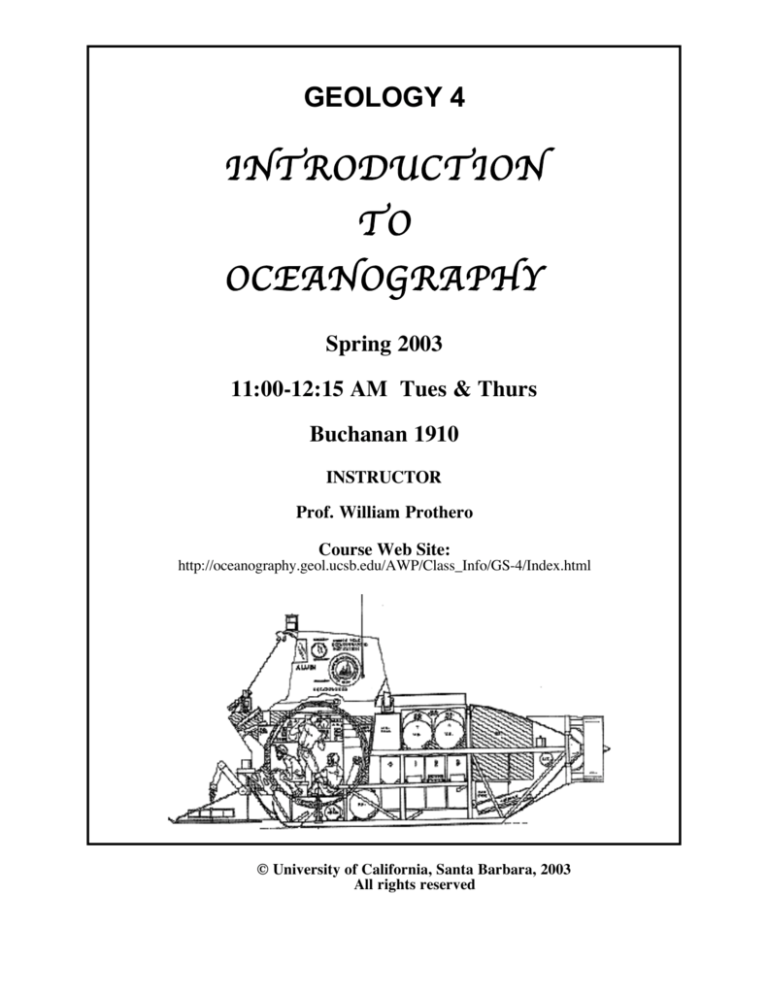
GEOLOGY 4
INTRODUCTION
TO
OCEANOGRAPHY
Spring 2003
11:00-12:15 AM Tues & Thurs
Buchanan 1910
INSTRUCTOR
Prof. William Prothero
Course Web Site:
http://oceanography.geol.ucsb.edu/AWP/Class_Info/GS-4/Index.html
© University of California, Santa Barbara, 2003
All rights reserved
Credits:
This manual and accompanying courseware was created by:
Prof. William A. Prothero
Holly E. Dodson
and Teaching Assistants,
Department of Geological Sciences,
University of California, Santa Barbara
Special thanks to C. Julie Esch, Graduate School of Education
with
Funding provided by:
National Science Foundation
Undergraduate Course and Curriculum Program
of the Division of Undergraduate Education
and
Office of Instructional Development
University of California, Santa Barbara
Course software information available at:
http://oceanography.geol.ucsb.edu/
GS-4 Lab Workbook Introduction
page ii
TABLE of CONTENTS
page
Overview of Class
Introduction
Information and Policies
Exams and Grading
Course Assignments Summary
Earth Summit Writing Assignments
Earth Summit Writing Assignments scoring guide
Weekly Thought Problems
Class Resources
1.
2.
3.
4.
5.
6.
How to Make a Class Presentation
Elements of a Science Investigation
Anatomy of a Science Paper
Writing with Integrity
Analyzing Scientific Claims
Fishing Down the Food Chain
Lab Discussion, Homework, Activities
Lab 1: Discussion – Getting Acquainted
Homework – Part 1- Getting Started; Part 2- Beach Walk
Activities
Guidelines for group work
Lab 2: Discussion – Maps and Elevation Profiles
Homework
Activities
Lab 3: Discussion – Interpreting Earth Data
Homework
Activities
Lab 4: Discussion – Atmospheric and Oceanic Circulation
Homework
Activities
Lab 5: Discussion – Earth’s Heat Budget and Climate
Homework
Activities
Lab 6: Discussion – Waves, land and sea interactions,
sediments, and coastal processes
Homework
Activities
Lab 7: Discussion – World Fisheries, the Fishing Game
Homework
Activities
Lab 8: Discussion – World Fisheries, Critical Thinking about Science
Homework
Activities
Supplementary Information
1. Metric system, conversion factors, etc.
2. Useful data about the Earth and ocean
3. Some elements in seawater
page iii
1
2
4
7
9
11
13
R-1
R-5
R-11
R-23
R-25
R-27
1-1
1-19
1-45
1-46
2-1
2-21
2-31
3-1
3-5
3-11
4-1
4-11
4-13
5-1
5-29
5-31
6-1
6-15
6-23
7-1
7-3
7-5
8-1
8-3
8-5
Appendix I
A-1
A-3
A-6
GS-4 Lab Workbook Introduction, Spring Quarter, 2002
4.
5.
6.
7.
Major types of oceanic phytoplankton
Classification of marine organisms
Sea water chemistry tables and figures
Geologic Time Scale
GS-4 Lab Workbook Introduction
A-8
A-9
A-10
A-15
page iv
Before the first class meeting:
Read the introduction to this workbook to learn what the class
is about, its policies, and what will be expected of you. You are
responsible for knowing this information.
Before the first section meeting:
* Read Lab 1 text
• Do Homework #1, parts 1 and 2 (see Lab #1)
First lab section meets: Second week of the quarter
Important Class Resources: http://oceanography.geol.ucsb.edu/
and "EarthEd3" CDROM (distributed in class)
Introduction:
Welcome to Oceanography! I hope through this course you will learn about the process of doing
science, learn how to access scientific information for yourself, and gain enough knowledge of how
the Earth works to make informed choices through your vote as environmental issues increasingly
conflict with economic needs. For every voice raising alarm, there is always an apparently well
informed voice claiming “All is well.” The only solution is for you to make up your own mind.
This is not an “environment” class. Some of the important environmental issues of our time will
be discussed, but the focus will be on “how the Earth works.” The title of the course,
“Oceanography,” is appropriate because the ocean has such a large effect on the Earth as a whole.
You will be learning about the solid Earth and processes that shape it, the atmosphere and climate,
the oceans, their physical properties, and life in the oceans.
THIS IS NOT A COURSE ABOUT FISH! Topics relating to fish and
fish populations will be discussed, but the emphasis is on Earth processes
relating to the oceans.
GS-4 Workbook Introduction
Page 1
At the end of the course, you should be able to:
® Analyze global environmental issues from the point of view of
a science advisor to a particular country.
® Know basic facts and processes about:
o
o
o
o
o
o
formation of the ocean basins, major features, and the role of plate tectonics
atmospheric circulation
ocean surface and deep circulation
how the ocean and climate interact, and the major ocean/climate phenomena
distribution of sea life and processes and environmental factors that influence it
Understand issues related to fishing and fisheries management
Course Information and Policies:
Course Objectives: This course is designed to not only teach you some basic facts about
the Earth, but to give you the experience of thinking like a scientist. You will learn to access
scientific information from the “Our Dynamic Planet” CD-ROM and World-Wide Web, and
develop some ability to think critically about science and scientific claims. You will also gain skills
in using the computer and in using real Earth data to make your own scientific judgments and
conclusions.
Earth Summit Conference: The course is organized around an Earth Summit conference
format. Kyoto was recently the site of a conference of world governments, with the purpose of
agreeing on limitations of greenhouse gases. Students will become part of a group that will
represent a country or region, and put oceanography in the context of that country’s geography and
economic conditions. During the last week of class, student teams, representing their countries, will
present recommendations for global environment and fisheries management.
Lab Sections: Lab sections are taught by Teaching Assistants. Your TA is an important
resource. During this section you will access Earth data, participate in group discussions, and work
on assigned exercises. The material for the laboratory part of the section is given in this
workbook. Each lab has a homework assignment that is due before the start of the section. Your
answers are entered into the computer connected to the Internet, which gives you an immediate
score and allows you to improve your scores at a later time.
Attendance at all sections is mandatory. Penalties for missed sections are heavy.
If you miss 2 sections, you will flunk this course, even if your other grades are
good. If you miss 1 section, your grade will automatically drop by 10% (one
grade point). All special situations must be arranged in advance.
Switching labs is allowed only if you have a documented schedule conflict. This must be done
during the first week of the class. If you need to switch labs, go to the lab section you want to
switch into and ask the TA. He/she will switch your section. But, don't miss a section by skipping
your scheduled section, then failing to get into a section that turns out to be full later in the week.
Missed Sections: If you miss a section, you miss the opportunity to work with your group.
Missed sections must be made up during the week that the class is involved in that particular lab
activity. If you are sick during an entire week, bring a doctor’s note to the professor, so that special
arrangements can be made.
Sections must be made up during the same week that you miss.
GS-4 Lab Workbook Introduction
page 2
Group Work: This course involves both individual and group work. Many students have
found that group activities in the course add to their interest level and learning. Your future
employment will most likely require you to work as a team member, so the ability to work in a
group is a valuable skill.
Honors Section: The honors section will meet for one hour per week. Students will be reading
“Climate Change and Human Society” by Ian D. Whyte. Each week a student will be responsible
for leading a discussion of a chapter.
Computer Use: UCSB oceanography students are fortunate to have a Macintosh computer
laboratory exclusively for this class. You will perform many of the section exercises using the
computer, integrated with group and class discussions. You will use computers for looking at
information relevant to the Earth, as well as writing, surfing the Internet, and getting your grades. If
you are new to computer use, don’t worry. The software has been used by many beginners and
they get “up to speed” quickly and grow to love the capabilities computers provide.
If you own your own computer and have Internet access, you will be able to use the "EarthEd"
CDROM at home to work on class assignments. Most students at UCSB now own their own
computers, but if you don’t, or if yours is too old to run the software, you can come to open access
hours in the Phelps Hall microcomputer lab.
Studying: I hope to make this course fun and satisfying. However, you will have to work hard
to earn a decent grade. It will require approximately 7 - 10 hours of outside studying per
week. Read the assigned textbook chapter before the lecture. Work all the study questions at the
end of the chapter. When you read the book, ask yourself “why” the particular phenomenon
occurs the way it does. Many students find it helpful to study in groups. Additional homework
help will be available in the special "Math Help" session.
Lectures: Material included in the lectures comes from a variety of sources, including your
textbook. Lectures are intended to emphasize the “why” of processes affecting the Earth. They are
also useful for defining the body of knowledge that you will be responsible for on the exams. You
will benefit most from the lectures if you have read the book first.
Lectures begin at the start of the scheduled class time. Because there are so many people in the
class, closing books, shuffling papers, etc. before the lecture ends makes an amazing amount of
noise and is disruptive to the other students and to me, since I’m trying to end gracefully. Please
wait until the lecture ends before you make preparations to leave. Also, please hold private
conversations during non-lecture hours. Value your environment. Start with the classroom.
Thanks!
Attending lectures: Regular lecture attendance is very important. If you miss lectures,
you miss important class announcements and in-class activities, not to mention a chance to hear the
material with the professor’s emphasis and the chance to get a more in-depth exposure to the
subject. You are responsible for all content and announcements delivered during the
lecture sessions.
Lectures will include in-class activities. These activities will involve answering specific
thought questions, with the help of a neighbor, and handing in written answers. These will
be graded as pass/no pass and will count toward your course grade. It will not be possible
to make up these activities if you miss class.
GS-4 Workbook Introduction
Page 3
AS Notes: Not available for this class.
Math and this class: The math level of this class is very basic. If you have math phobias,
a special help session is offered to help you. It would be a shame for you to get a college education
and not be able to do the simple math that this class requires.
Students with physical disabilities: One of the lab sections meets outside the lab.
If you have a disability, e.g. if you are confined to a wheelchair, let the TA know at least one week in
advance of the section requiring assistance and he/she will make special arrangements.
Open Access Hours: In the past, we staffed the PSB oceanography lab during certain
hours for open access. Since so many students have their own computers, these have become
extremely poorly attended. So, the EarthEd Online software has bee installed in the Phelps Hall
microcomputer labs. The specific labs where it is installed will be announced in class and posted on
the class web site. You are also welcome to use vacant seats in PSB during scheduled lab sections,
providing you sit at the back of the room to avoid distracting the section.
Grading: Grades will be assigned to:
a) Lab homeworks
b) Lab activities
c) Earth Summit papers
Tectonics
15%
Climate
15%
d) Final Earth Summit Presentation
e) In-class activities
f) Thought problems, and Extra credit
g) Final exam
Total
(10%)
(20%)
(30%)
(10%)
(10%)
(10%)
(20%)
110%*
*All grades are assigned as A is 90-100%, B is 80-89%, C is 70-79%, D is 60-69%, and F is below
60%. Because the total grade is 110%, students will be able to choose assignments that best fit their
learning style.
Policies for computer graded prelab homeworks: Computer grading of the
homework assignments allows you to get immediate feedback on your answers and lets you redo
missed answers to improve your grade. This also frees your TA from the job of grading
homework, which frees him/her to spend more time helping you with course content. I think it's a
good deal for everybody.
These policies have been structured to reward students who do their work on time (thus get the
greatest benefit from it). Yet, it also allows those who pace themselves differently to succeed and
encourages students to correct missed answers.
Condition
• Homework entered before its "due" lab
section meets:
Scoring
The highest grade is your homework grade.
** Maximum total tries specified on homework index
screen.
0-1 week late: 10% penalty
1-2 weeks late: 20% penalty
> 2 weeks late: 50% penalty
• Homework is late if it is entered more than 30
minutes past the scheduled start of your
section.
• Penalties only apply to improvements in scores. For example, if you get 70% with no penalty,
then another 30% with a 10% penalty, the penalty will only be applied to the 30% and your final
score will be 97%. At the end, you will improve your grade by getting all of your answers correct.
GS-4 Lab Workbook Introduction
page 4
• You are allowed to improve your homework scores by correcting your answers. However, to
discourage simply trying all combinations of answers, after the specified number of tries, each new
try will reduce the possible maximum score by one percentage point. So, a perfect score at try four
would have a maximum of 99%, at try five, 98%, etc. Late penalties will also apply.
Policy for TA graded homeworks: It is our policy to grade homework assignments
within one week of their due date. If your homework grade is not received according to this policy,
please contact your TA or the professor.
Save all returned work! This is a very large class. Mistakes happen. Save your work in
case you don't get credit for it. Your saved work is your only proof that you have done the
work.
If you take this class P/NP, a C minus will register as a fail. If you are taking this class to
satisfy an upcoming graduation requirement, P/NP options can be extremely risky.
Academic Standards: Improper academic behavior can result in as little as a loss of
credit for the assignment and as much as suspension from the University. Please avoid even the
appearance of cheating. However, collaboration with fellow students is encouraged for all
assignments. But, when you collaborate, you must write up your work individually and list your
collaborators on the assignment.
Be sure to read “Writing With Integrity” in the resources section.
Distributing homework answers to others diminishes the learning
experience, and will be considered cheating.
Professor Prothero and graduate students launching Ocean Bottom Seismometer capsule in Santa
Barbara Channel to record earthquake aftershocks.
GS-4 Workbook Introduction
Page 5
Blank
GS-4 Lab Workbook Introduction
page 6
Course Assignments Summary
Assignments are due every week. Several of the assignments require advance work, so be sure to
plan ahead by reading the required assignment well in advance.
All homework assignments are found within the body of the lab section chapters or on-line. Be sure
to check the class web site for the latest information. A checklist is given at the start of each lab
section, to remind you of homework assignments and reading requirements prior to the lab section.
Written Assignments: There are several written assignments. These count for a significant
part of your course grade. You may be asked to bring extra copies to the lab section, for the group
review activities.
• Beach walk written assignment (due at beginning of lab section #1, five copies required)
• Earth Summit Tectonics paper (due at beginning of lab section #4 [week 5])
• Earth Summit Climate paper (due at beginning of lecture Thursday of week #8)
Earth Summit Country Group Presentations: You will be asked to participate in
several group presentations during the lab section.
• Earth Summit Tectonics group presentation in lab #3
• Earth Summit Climate group on-line presentation due before lab #6*
• Earth Summit Final group presentation with fisheries information in lab #8
*The online group presentation: The lab #6 group presentation must be done online,
because students will be at the beach. Because software for this activity is changing, the
specific format of this presentation will be posted on the class web site. Check it out.
*Extra Credit* If your group is selected by your TA you will be asked to give a presentation to
the entire class during the week 10 lectures. This is the Earth Summit Conference that we are
holding. You might instead be asked to sit on a panel where you will be interacting with the
presenters. Again, you will receive extra credit for this active participation.
Weekly assignment descriptions:
Thought problems will be due prior to the first lecture of each week (beginning in week 3 of the
course) and will address your reading assignment, content that is not yet covered in lecture. You will
access the assignment from the homework screen. The software will post your answers to your
section forum. After you have posted an answers, you will be able to view and respond to other
students’ answers. No credit will be given for late entries. The TAs will grade your entries.
Exemplary answers will receive 100%, acceptable answers will receive 85%, and weak answers will
receive 70% credit. The answers must be one or two sentences long and directly address the
question.
Content quizzes are due prior to the second lecture of each week (beginning in week 3 of the
course) *and will address content that has been covered in lecture. The quizzes will be randomly
selected from a database of questions and you may retake the quiz as desired. Only the highest
score will count toward your course grade. Many of the questions in these quizzes will appear on
the final exam, so it is to your advantage to take the quiz a number of times. Students frequently ask
why they didn’t get 100% when they correct their answers. The answer is that only the first try at
the quiz will count. You need to go back to the homework list and re-select the homework to get a
new quiz. However, you can retake the quiz just to find the correct answers, even if it doesn’t count
toward your grade.
GS-4 Workbook Introduction
Page 7
Lab section homework assignments are due at the beginning of each lab section. They cover
course content and information needed for the upcoming lab section. Assignments may be done
late, but penalties will apply. Please refer to the grading policies discussed previously.
UCSB Writing Requirement Credit: The GS-4W version of Introduction to
Oceanography satisfies a College of Letters and Science writing requirement.
Final encouragement: The large size of this class, and the varied student body require
that clear rules be enforced. Most of you will find these rules fair and that they reward your diligent
efforts with good grades. Students from previous Oceanography classes have found the computer
work rewarding and provide them with many opportunities to show they are learning the material.
They also like the feedback that online grades give them. The material is interesting and very
important to those who will be occupying this planet during the next 50-60 years. Good Luck!
Oceanography Course Assignments Summary
Spring
Week
#
1
2
Quarter,
2003
Lab Lab Section
#
0
No lab this week
1
Getting Acquainted
3
4
5
2
3
4
Maps and Profiles
Interpreting Earth Data
Atmosphere and Ocean
6
7
5
6
Climate
Waves and Beaches
8
7
World Fisheries #1
9
8
World Fisheries #2
10
Final
Exam:
9
Review sessions
Earth Summit Country
Group Presentations
Writing Assignments
Beach Walk
Description
Plate Tectonics (in section)
Plate Tectonics: due
beginning of lab
section
Oceans and Climate
(online)
Oceans and Global
Climate: due second
lecture of the week.
Final Earth Summit
Presentation with fisheries
(in section)
Weekly Assignments
Where to find
Due
Thought questions
Content quizzes
Lab section homeworks
Online
Online
Online
Beginning of first lecture of week*
Beginning of 2n d lecture of week*
Beginning of lab section
*Thought questions and content quizzes do not begin until the 3rd week of the class.
Read “Writing with Integrity” in the
Resources section of this workbook.
GS-4 Lab Workbook Introduction
page 8
Earth Summit Country Group Presentations:
The purpose of the Earth Summit presentations is to give you a chance to broaden your perspective
by collaborating with your country group, collect your thoughts, and get feedback from your peers,
before you write your position paper. This is analogous to the way scientists give short talks at
professional meetings prior to submitting their work, in written form, to a scientific journal. Talks at
meetings allow researchers to introduce their ideas to their colleagues, hear their colleagues’ ideas
and refine their own ideas. It is this sharing of ideas between scientists that supports the stimulating
intellectual enterprise that we call “science.”
You are responsible for several Earth Summit presentations. The content should be a start on your
writing assignments, which you might think of as “position papers.” Resource 1, in this lab
manual, gives information on how to create your presentation.
The online group presentation: The lab #6 group presentation must be done online, because
students will be at the beach. Because software for this activity is changing, the specific format of
this presentation will be posted on the class web site. Check it out.
Earth Summit Writing Assignments:
The requirements for your papers are discussed in “Anatomy of a Science Paper,” in the
Resources section of this lab book. It is vital that you read it carefully. It focuses on the plate
tectonics paper and use of data from the class CDROM, but the principles will generally apply to all
of the assignments.
Plate Tectonics: Plate tectonics has both global and local influences. You can pick from a
number of possible problems about plate tectonics, but must address issues of how plate tectonics
affects your Earth Summit country. The concentration is on using data from the class CDROM to
argue for a particular plate tectonic model. You must also include specific information about your
country that will be relevant to the effect of your plate tectonics model on your country. For
example, a sparsely populated country may feel few effects, but a densely populated country with
population concentrated around active volcanoes could be seriously affected. Be creative and think
about what kinds of considerations you would have, given the facts of plate tectonics.
The length of the paper will be 1000 to 1200 words (maximum). This is three to four doublespaced pages, not counting figures, captions and references. In order to adequately cover your topic,
you will need to be concise. As a guideline, you could use the following approximate divisions of
content:
Content Guidelines:
• Abstract:
100 words
• Introduction:
100 words
• Methods
100 words
• Observations
300 words
• Interpretations
300 words
• Discussion
200 words
• Conclusions
100 words
• References (not included in word total)
Various lab section activities will prepare you for this writing assignment.
GS-4 Workbook Introduction
Page 9
Oceans and Global Climate: This is still a science paper, but is weighted a bit heavier on
policy and impacts. Your Earth Summit country will have a particular interest in one or more of the
topics listed below. You will need to decide the most important topic(s) to address.
You should put your local issues in the context of global processes. Use data. For example, if you
are talking about sea level rise, show data on sea level rise. Relate your topic(s) to the global “big
picture.” You could discuss how the regional environment differs from global patterns. Use the
data from the WorldWatcher CD and the Internet.
Content Guidelines: same as Plate Tectonics Paper
Issues you could address in your writing assignment (feel free to develop others that are
not in this list: check with your TA):
• Climate biozones
• Precipitation Patterns
• Pollution
• Wind patterns
• Ocean circulation patterns (e.g. effect on local weather)
• Effects of global warming on your country
• What your country adds or doesn’t add to global warming
• Ice cap melting and sea level changes
• Yearly events (e.g. monsoon and other seasonal events)
• Effects of El Nino and La Nina
• Ozone hole effects
• Variations in precipitation (drought/deluge)
• Volcanic eruptions affecting local conditions (e.g. Mt. Pinatubo eruption)
• Changes in albedo (deforestation, melting ice caps)
Use the mini-studies in labs 5 and 6 to guide you in your data
explorations of particular environmental/science issues.
Other hints: Someplace in your paper, you should discuss the most important global climate and
environmental issues, from your country’s perspective. Some countries will find pollution reduction
to be highest on the list while others may not. Is population a factor? For example, Canadian lakes
in the far north are acidifying due to pollution emitted by northeastern U.S. industrial activity.
Therefore, Canada can be expected to be interested in emission and pollution controls.
It is not necessary to address every climate and environmental issue affecting your country.
Instead, choose the topic or topics of greatest interest/impact to your country. It is preferable to
discuss one topic thoroughly than to skim multiple topics.
Where to get information: There are many source of information on the Internet and in the
library. The WorldWatcher CD has both climate and demographic information. Please check the
oceanography web site for a list of resources and Internet links to resources.
GS-4 Lab Workbook Introduction
page 10
Earth Summit Country Plate Tectonics paper scoring rubric:
Student’s name:__________________________Perm:_____________________
Graded by:____________________
Overall:
Item
1. Clear (readable), focused and interesting
2. Accurate punctuation and spelling
3. All paper sections are included and include the appropriate content.
4. Figures are numbered, clearly annotated, referred to in the text, and have
informative captions. (Credit is reduced for using too many figures).
Abstract
1. Complete yet and concise description of the investigation and its results
Introduction
1. A clear, solvable problem is posed, based on an accurate understanding
of the theory of plate tectonics, and the inquiry assignment.
2. Adequate country background information is included.
Methods
1. Demonstrates an understanding of the data and its inherent limitations.
2. References the data sources.
Observations
1. Observations are clearly supported by figures that show data and
location of data when appropriate.
2. Clear description of data and data representations
3. Descriptions of features as identified by data
4. Relationships between observations are made clear
Interpretations
1. A clear figure that describes the model, or theory that your investigation
is attempting to support (must be student-drawn).
2. The problem, model, and supporting data are clearly connected in the
text and figure(s), showing that the interpretations follow logically from
the data.
3. The model figures are clear and show the correspondence between the
observations and the model. (Data or observations are shown on the
model sketches and clearly indicate the correspondence between data and
model features.)
4. A clear distinction is made between portions of the model that are
supported by data from this investigation, portions supported by other
references or background knowledge, and those that are supported by
neither this investigation or other references.
Discussion
Discussion clearly illustrates the broader aspects of plate tectonics theory
that apply to the investigation. Irrelevant content here will result in a lower
score.
Conclusions
Conclusions clearly describe the major findings of the paper.
References
1. References in correct format
2. Data and others’ work are adequately referenced.
GS-4 Workbook Introduction
low – med - high
0–1–2–3-4
0–1–2–3-4
0–1–2–3-4
0–1–2–3-4
0–1–2–3-4
0–1–2–3-4
0–1–2–3-4
0–1–2–3-4
0–1–2–3-4
0 – 2 – 4– 6 - 8
0 – 2 – 4– 6 - 8
0 – 2 – 4– 6 - 8
0 – 2 – 4– 6 - 8
0 – 2 – 4– 6 - 8
0 – 2 – 4– 6 - 8
0 – 2 – 4– 6 - 8
0 – 2 – 4– 6 - 8
0 – 2 – 4– 6 - 8
0 – 2 – 4– 6 - 8
0–1–2–3-4
0 – 1 – 2– 3 - 4
Page 11
Points
Earth Summit Country climate paper score rubric:
Student’s name:__________________________Perm: _____________________
Graded by:____________________
Overall:
Item
1. Clear (readable), focused and interesting
2. Accurate punctuation and spelling
3. All paper sections are included and include the appropriate content.
4. Figures are numbered, clear and easy to read, referred to in the text, and
have informative captions.
Abstract
1. Complete yet and concise description of the investigation and its results
Introduction
1. A well-defined topic is introduced and its importance is well-justified.
2. Adequate country background information is included.
Methods
1. Demonstrates an understanding of the data and its inherent limitations.
2. References the data sources.
Observations
1. Observations are clearly supported by figures that show data and
location of data when appropriate.
2. Clear description of data and data representations
3. Descriptions of features as identified by data
4. Relationships between observations are made clear
Interpretations
1. Adequately describes processes supported by the data, making good
use of cartoon-type sketches and diagrams where appropriate.
2. The problem, model, and supporting data are clearly connected in the
text and figure(s), showing that the interpretations follow logically from
the data.
3. The model figures are clear and show the correspondence between the
observations and the model.
4. A clear distinction is made between portions of the model that are
supported by data from this investigation, portions supported by other
references or background knowledge, and those that are supported by
neither this investigation or other references.
Discussion
Discussion clearly illustrates the broader aspects of the relevant theory that
apply to the investigation. Irrelevant content here will result in a lower
score.
Conclusions
Conclusions clearly describe the major findings of the paper.
References
1. References in correct format
2. Data and others’ work are adequately referenced.
GS-4 Lab Workbook Introduction
low – med - high
0–1–2–3-4
0–1–2–3-4
0–1–2–3-4
0–1–2–3-4
0–1–2–3-4
0–1–2–3-4
0–1–2–3-4
0–1–2–3-4
0–1–2–3-4
0 – 2 – 4– 6 - 8
0 – 2 – 4– 6 - 8
0 – 2 – 4– 6 - 8
0 – 2 – 4– 6 - 8
0 – 2 – 4– 6 - 8
0 – 2 – 4– 6 - 8
0 – 2 – 4– 6 - 8
0 – 2 – 4– 6 - 8
0 – 2 – 4– 6 - 8
0 – 2 – 4– 6 - 8
0–1–2–3-4
0 – 1 – 2– 3 - 4
page 12
Points
Weekly Thought Problems
The Thought Problem assignments are found by launching EarthEd and going to the Homeworks
screen. To get credit for the Thought Problem assignment, you must do it before the first lecture of
the week it is assigned. After you submit your answers, you will be able to read other students’
answers and engage them in a dialog on the BBS/Forum for the assignment.
These questions are chosen so that there is often no right answer. The TAs and Prof will review
your answers each week and give you a score. To maximize your score, you should post a credible
first answer, then add to it in the Thought Question forum. You can reply to others’ answers or
reply to your own. You are encouraged to make this an interactive online discussion.
Answers should only be a few sentences. Conciseness is rewarded.
Due at beginning of week 3 (Plate Tectonics TQ)
1. The Pacific Ocean is ringed by earthquakes and volcanoes, but the Atlantic Ocean is not.
Why is this?
2. What is the difference between the crust and lithosphere? The lithosphere and
asthenosphere?
3. Sediments are always being transported from the continents into the ocean basins. In the 4.5
billion year lifetime of the Earth, why aren’t the ocean basins filled, or at least very flat?
4. How can you tell the difference, using data, between convergent, divergent, and transform
plate boundaries?
Due at beginning of week 4 (Atmosphere TQ)
1. Why is the atmosphere stratified in the vertical direction?
2. What causes mixing in the atmosphere? Why doesn’t the atmosphere just stay in one
place?
3. What are the processes that create the climate zones?
4. Why is the Coriolis effect so important?
Due at beginning of week 5 (Ocean Currents TQ)
1.
2.
3.
4.
What is geostrophic flow?
Why are ocean currents strongest in the Western parts of the ocean basins?
What is thermohaline circulation, how does it occur, and why is it important?
Why is salinity sometimes lower near the equator? Shouldn’t there be a great deal of
evaporation occurring?
Due at beginning of week 6 (Climate TQ)
1.
What is the strongest evidence that supports the idea of human-man caused global
warming?
2.
What is the strongest evidence against the argument that human activities are causing
global warming?
3.
What might the climate of the Earth be like if water evaporated at 0 degrees C.
4.
What are likely to be the most important consequences for civilization, of global
warming? Consider both positive and negative effects.
Due at beginning of week 7 (Waves TQ)
1. What effects do open ocean waves have on the Earth’s climateat is the main phenomenon
that generates ocean waves?
2. What are the main factors that determine the size of ocean waves?
The West and East coastal zones of the U.S. are quite different. How are they different and why?
How could you measure the average wavelength of a wave, in the deep ocean, with a stopwatch?
3. Why are points rocky and coves sandy?
4. Jack Richson wants to build a seawall to protect the cliffs in front of his home. What are the
pros and cons of doing this?
Due at beginning of week 8 (Productivity TQ)
1. What are the major world fisheries (see “Fishing down the Food Chain, resource #6)?
2. What are the some of the factors that contribute to a decline in a particular fish species?
3. What are some of the factors that contribute to a healthy fish population?
4. Where are most of the fish caught? Why are there oceanic deserts?
GS-4 Workbook Introduction
Page 13
Due at beginning of week 9 (Fisheries TQ)
1. In the reading resource “Fishing Down the Food Chain”, what is meant by fishing down
the food chain and what are some of the consequences of doing this?
2. What are some of the solutions to overfishing that are discussed in “Fishing Down the
Food Chain?”
3. Denitrification can have serious consequences. What is it and what are the consequences?
4. Portions of the Gulf of Mexico, near to where the Mississippi River flows into it, are
becoming almost devoid of oxygen and oxygen consuming life. What’s going on? Is this a
positive development?
5. In GS-4W, what subjects have you found particularly interesting? Has your curiosity about
other Earth topics been stimulated? What topics?
GS-4 Lab Workbook Introduction
page 14


